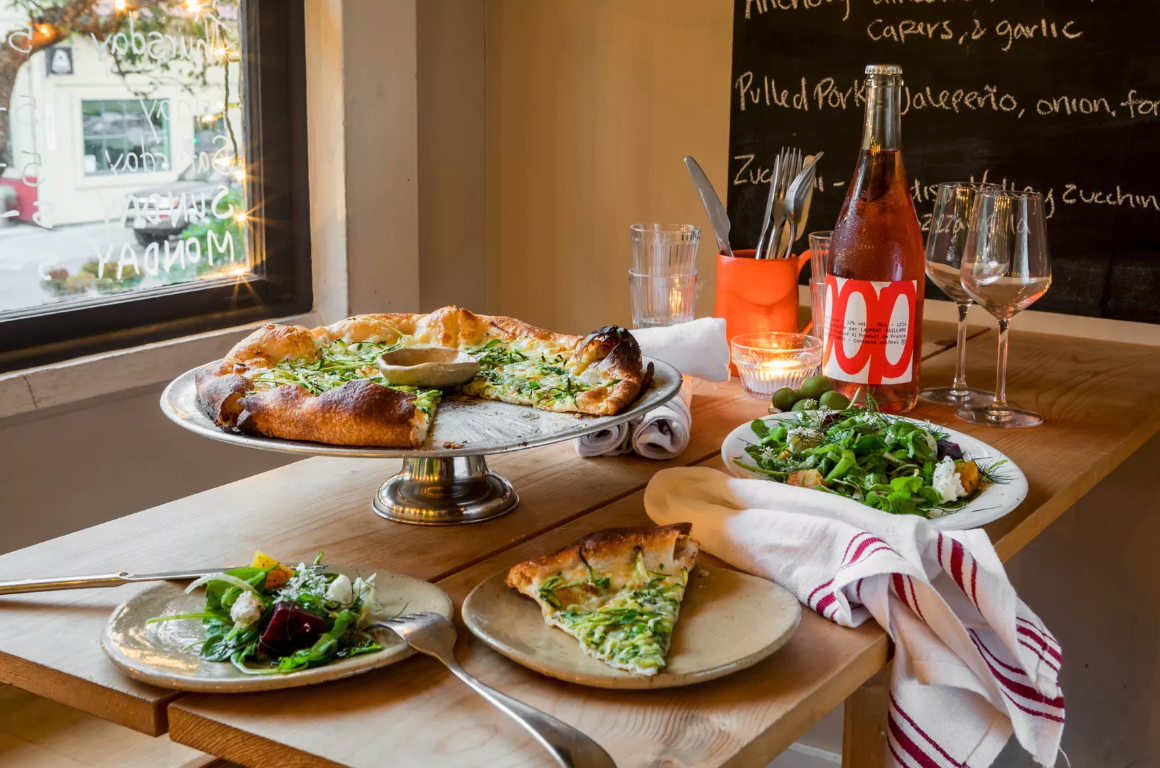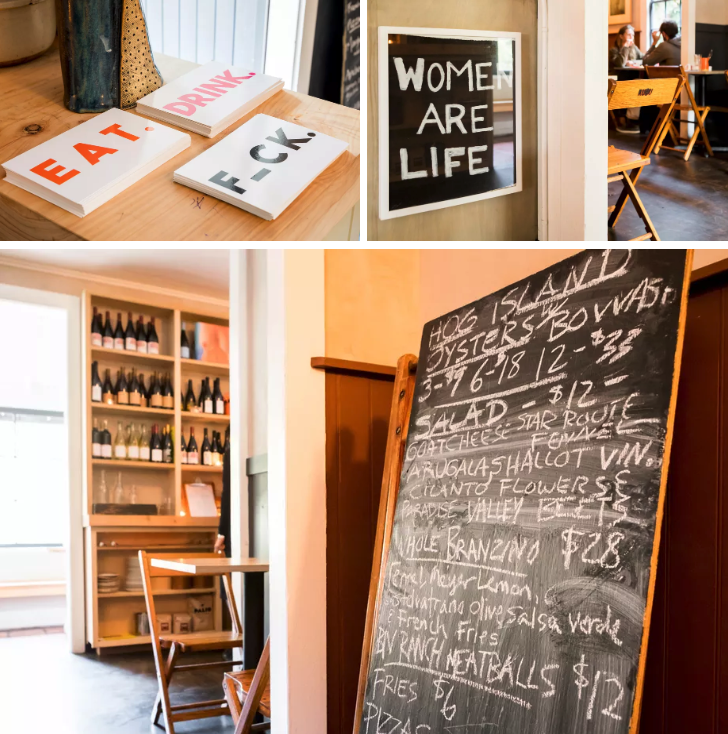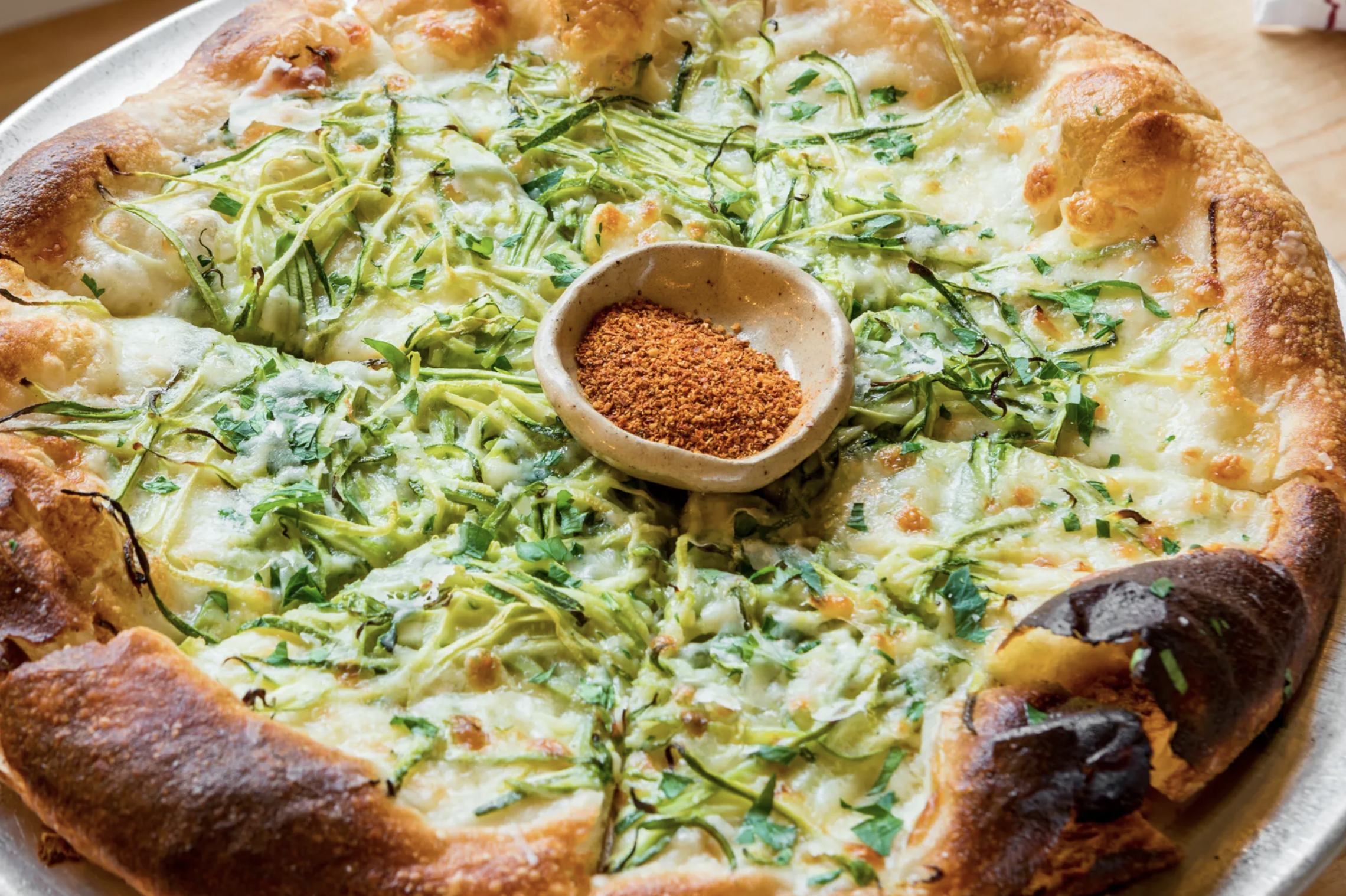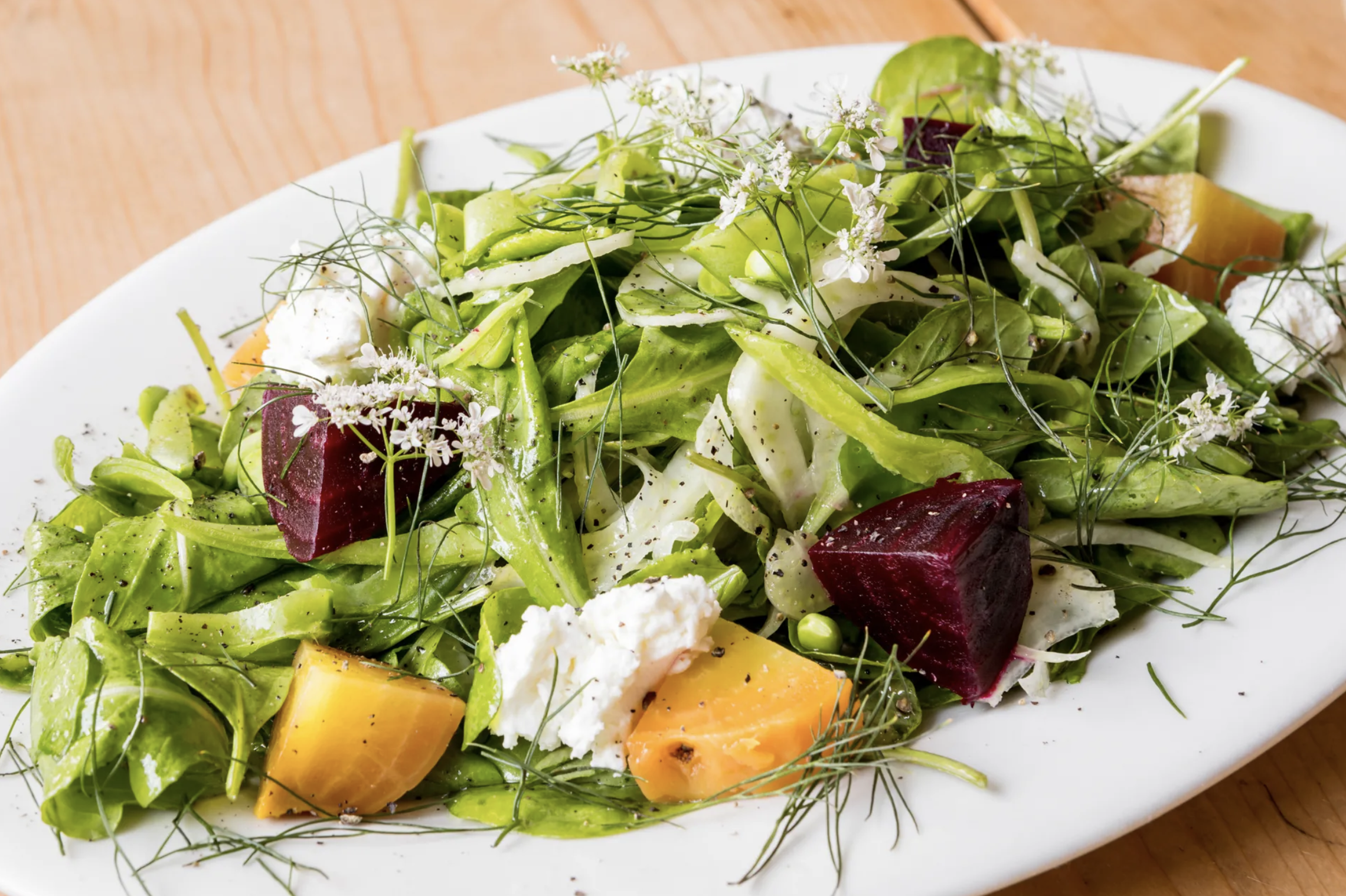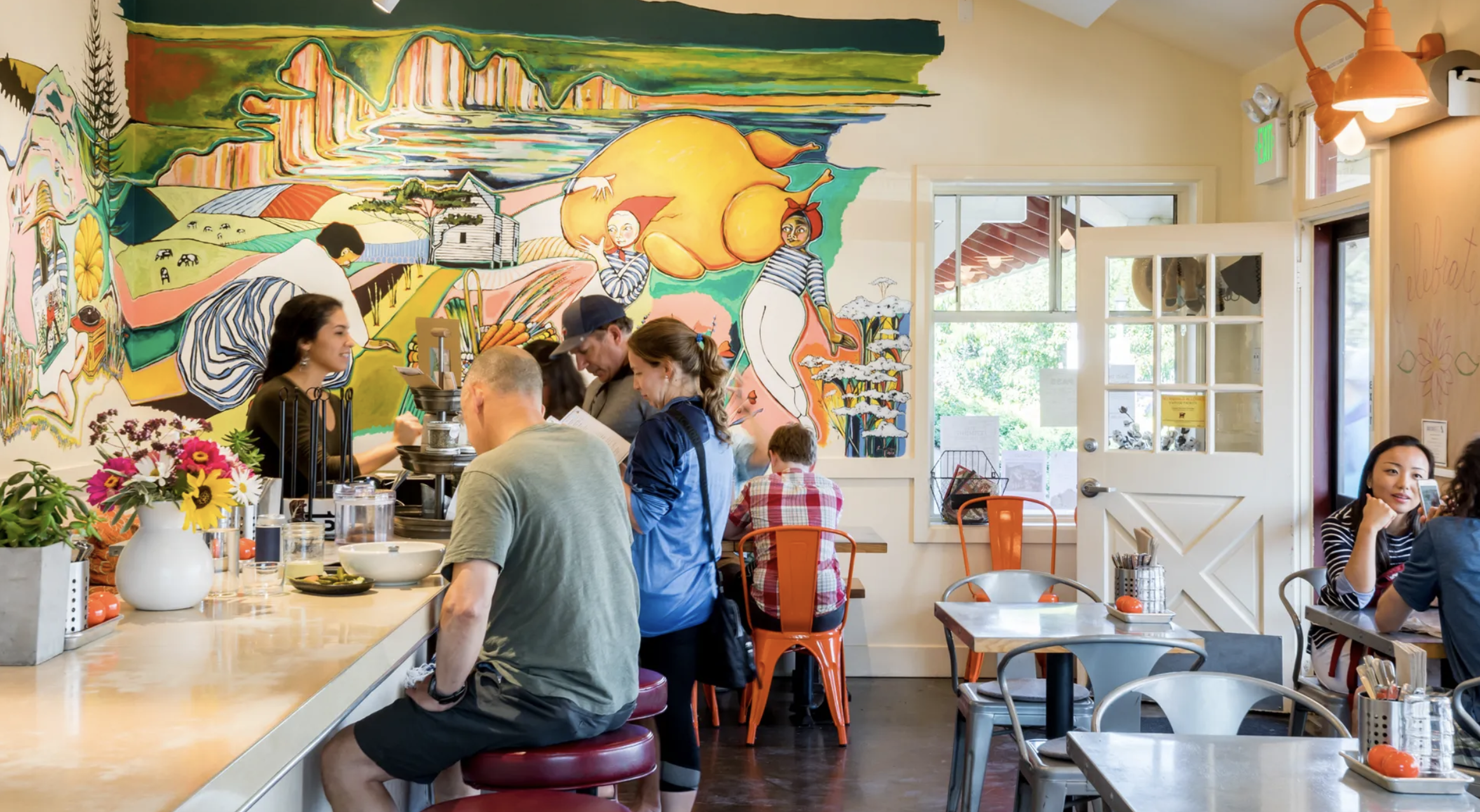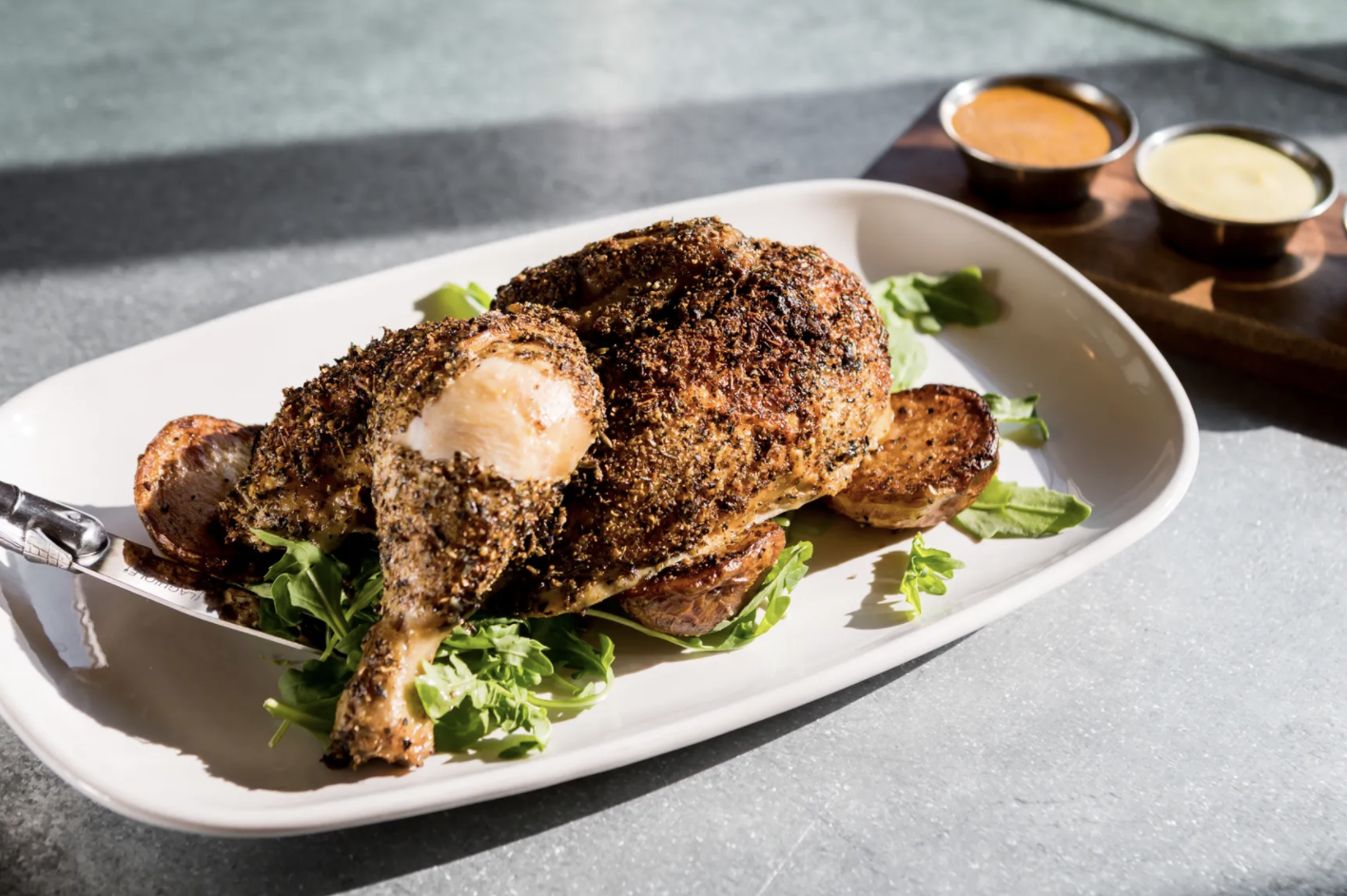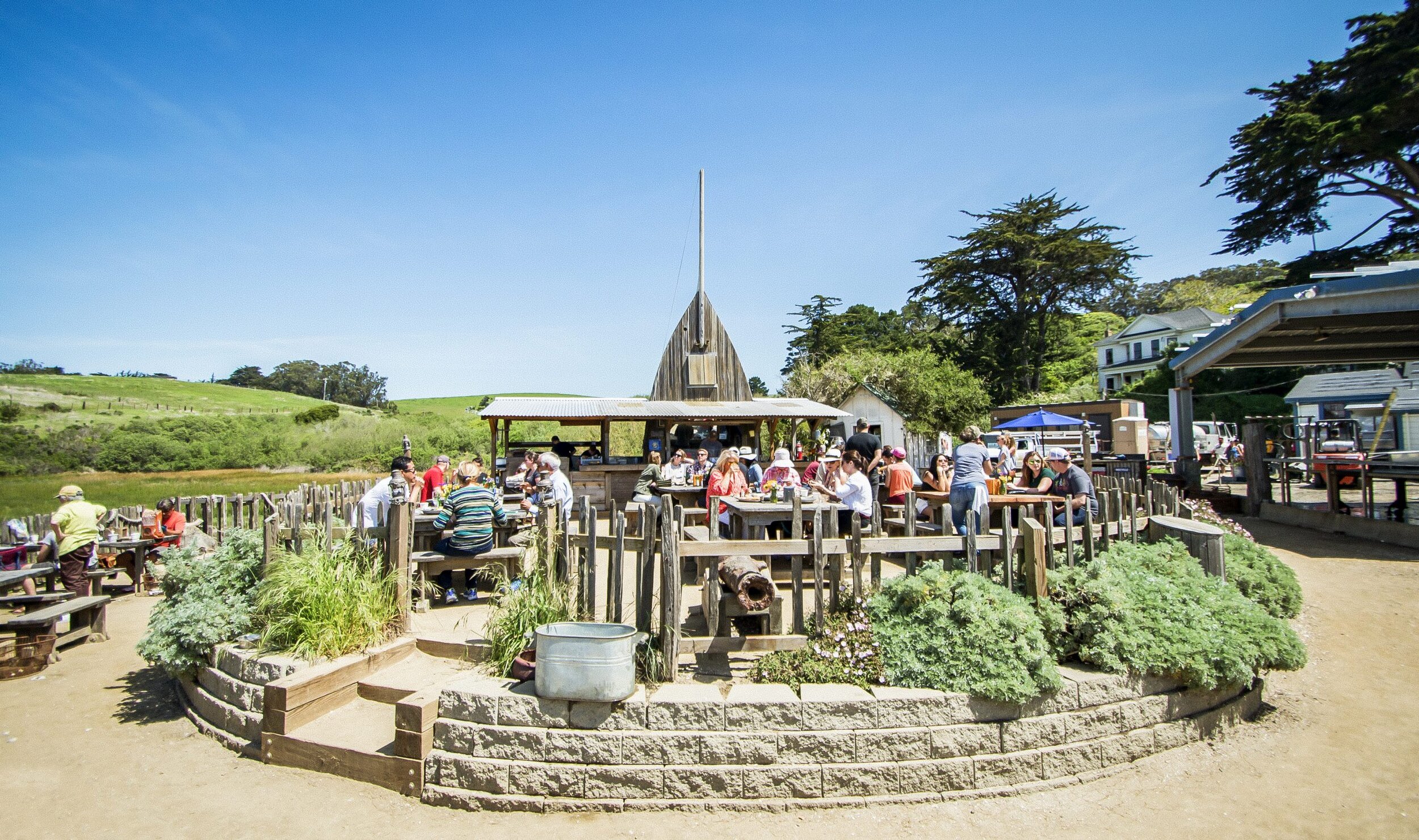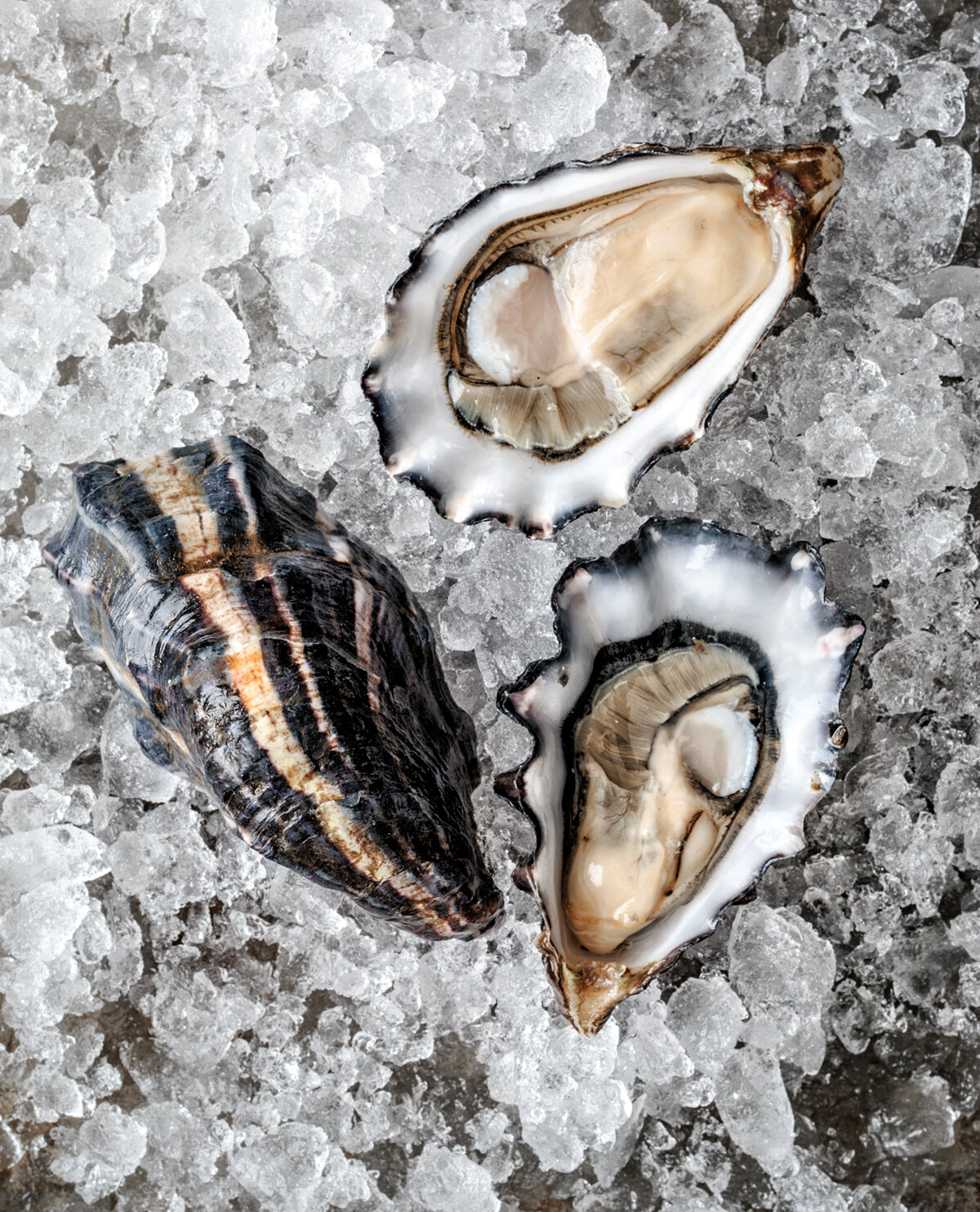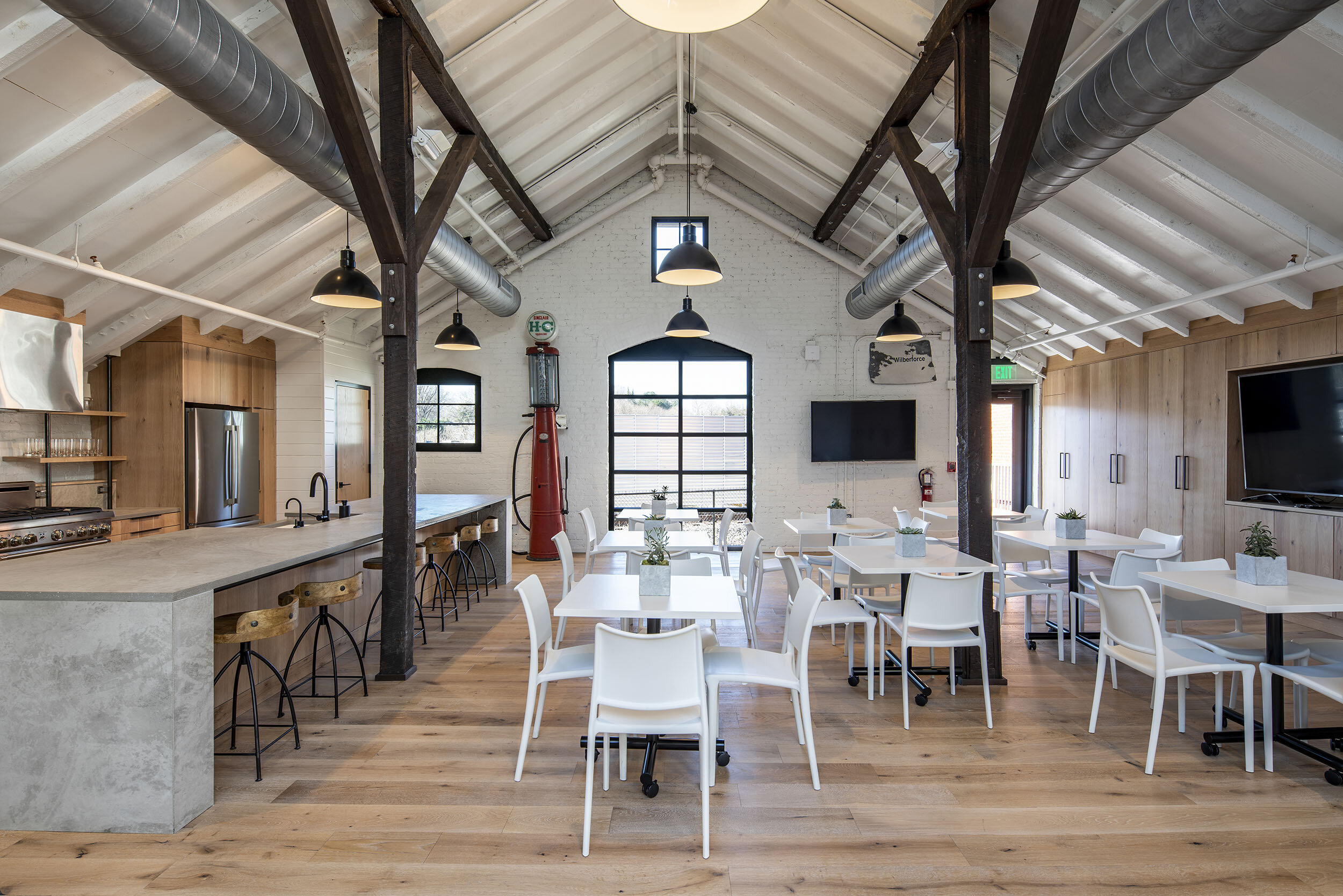by Rachel Levin@rachellevinsf Aug 15, 2018 | Photos by Patricia Chang
Eleven
Bolinas
Last August, sisters Kate and Rebecca Sterlin reopened the long-shuttered Blue Heron at 11 Wharf Road, renamed it Eleven, and brought Bolinas its first wine bar — and second restaurant.
Bolinas has long been touted as a “hidden” hippie surf village. But now Google maps demystifies the unmarked road into town and the surfers and artists and aging rock stars are joined by tech-millionaire third-home owners.
Before Eleven came along, the main drag had just one beloved place to sit down and eat, called Coast Café, and one salty dive bar to stand around and drink: Smiley’s. The saloon has been over-serving locals since 1851, through the 1906 earthquake, Prohibition, everything. In 2015, it changed to new owners, Leila Monroe and Ashley Huck. They haven’t changed much about Smiley’s — other than maybe to add a few more types of beer on tap — but that’s okay: Smiley’s regulars, like most Bolinas locals, aren’t big on change.
Eleven, though, is shaking things up. On a recent Monday eve, the first thing I see when I enter, toting my two kids, is a photograph of two ginormous naked breasts on a book cover, perched high on a shelf. Below it is a chalkboard scrawled with the simple truth: “Women Are Life.” And strewn atop the host stand is a colorful assortment of postcards, each printed with a fitting command for a restaurant with two inn rooms upstairs: “Eat.” “Drink.” “F_CK.” My 6-year-old son, who can’t read, picks up the “F_CK” one and asks: “Can I keep this?”
Turns out, Monday night is taco night at Eleven. Its website doesn’t say so, but clearly everyone here knows. The 1890s farmhouse, renovated by the Sterlins’ brother, Matt, is packed. In part because most West Marin restaurants are closed on Mondays, but also because of the corn tortillas, which are thick, chewy, and handmade.
El Salvadoran line cook Karina Borjas patted them out for staff meal one afternoon, and they were such hit, now seemingly everyone in town enjoys three for $20, topped with shreds of tender carnitas, crumbles of cotija, and a tad-too-liberal splatter of crema.
Taco night might morph into Haitian night this fall, say the sisters, whose father was Haitian. Local fish cooked in a coconut broth with scotch bonnet peppers and a little lime sounds nice. In winter, maybe they’ll do British night, in honor of their mom. Perhaps shepherd’s pie and a cuppa Berkeley’s Leaves and Flower tea, they say.
Otherwise, Eleven is all about Neapolitan-style pizza, on-trend natural wines, and the off-menu purpose of bringing the community together. That community happens to include the low-key and legendary Frances McDormand, who lives nearby with her husband, Joel Cohen. They stroll by our table at Eleven one night to say “hi” to another. She’s in yellow clogs, chomping a pizza crust, and I swoon.
Sir & Star at the Olema
Olema
Since it opened with lots of fanfare and accolades in 2013, Sir and Star seems to have fallen out of the media’s eye, and I’m not sure why. Maybe it’s because it’s not new anymore, or because the hyperlocal philosophy that owners Margaret Grade and Daniel DeLong pioneered in the late 1990s at Manka’s Lodge isn’t new either. Or maybe it’s because Sir & Star occasionally has an off night. But when it’s on, it’s on.
Walking through the gray door always feels like a somewhat haunted homecoming
I’ve written about the restaurant several times in my pre-critic life — yes, the owners know me by now — and walking through the gray door always feels like a somewhat haunted homecoming.
The fireplace roars; the candelabras flicker soft light against the warm white walls; the cormorant, stuffed and adorned in an ascot, stands tall on the mantle; and the house-made pull-apart rolls — accompanied by heavenly, honey-laced local butter — are always warm. Sir & Star’s signature “Faux Gras” of duck livers (described on Grade’s lyrical menu as “So Delicious It Should be Illegal”) is, indeed, delicious.
And now there are new dishes to try. A trio of sweet, puffy, steamed buns crammed with crisp roasted duck is flanked by a swipe of spicy espelette on one side of the plate and a sticky plum sauce on the other. A Marin Sun Farms “forest pigeon,” squab marinated in sea salt, sweet wine, and thyme, arrives, feet intact, shrouded in a knot of delicately fried potato ribbons. Only the oysters fail to impress: Also fried, they come plopped in a puddle of ranch dressing and scattered with sweet corn niblets on an open-face tortilla, taco style. Too froofy. I could barely distinguish the oyster — a sad and ironic development in a region so celebrated for them.
But no matter. Other places in Point Reyes might rely on Tomales Bay’s famed mollusks, but at Sir & Star, almost every item on the fairly priced menu has been harvested or hunted, foraged or fished “within arms’ reach.”
It’s not oysters that give Sir & Star its deep sense of place, it’s Grade. With her artist’s eye and quirky wit, gravelly voice and cloaked garb, she sails through Sir & Star’s multiple rooms like Madeline’s Miss Clavel, tending to diners. She’s spent two decades alongside DeLong, feeding people — locals, travelers, food-world royalty, even real royalty — in a way that only they, and West Marin, can.
10000 Sir Francis Drake Blvd., Olema
Photography: Brandi Potter
Side Street Kitchen
Point Reyes Station
When I heard the chef-owner team behind the longtime and lackluster Station House Café was taking over the old Pine Cone Diner, which closed in 2015, I was bummed. How about some new blood in a tiny town that hasn’t seen a new restaurant since Osteria Stellina back in 2008?
But then I wandered into their year-old Side Street Kitchen for an early weeknight dinner. I was happy to find starters like a delightfully fishy smoked-trout dip and crisp cups of little gems just harvested from Big Mesa Farm, then doused in a creamy-light buttermilk dressing.
The star of the short menu is the rotisserie chicken, proving that even Point Reyes isn’t immune to urban trends. Crisped, herb-rubbed skin conceals moist, flavorful meat, flanked by a trio of sauces: a spicy chimichurri, mild curried yogurt, and fresh salsa verde. It’s a chicken that holds its own against San Francisco’s flock. Side Street is only the fourth restaurant to inhabit this six-decade-old space, and — like its predecessors — it has staying power.
The food is as clean-tasting and fresh as its sunny, simple modern-diner decor. I came back midday and sat outside at a picnic table with a pan-seared Idaho trout and watched the tourists across the street flow in and out of Tomales Bay Foods, collecting wheels of Cowgirl and $17/pound kale Caesar and ham-and-Tam sandwiches, for what inevitably amounts to the most expensive picnic on the planet. For a second, I felt sorry for Side Street, until soon enough, a small line formed outside its flimsy screen door, too — the librarian on her lunch break, a duo of construction guys, a table of resident retirees. Between 5 p.m. and 7 p.m., parents swing in to pick-up a $40 “family meal”—a whole chicken, roasted potatoes, and little gem salad to go.
Day hikers, too, take note: There’s a new option in town, one that offers easy, affordable, nourishing fare, without the crazy scene of Cowgirl, or the carpet of Station House (which — to its credit — makes a mean breakfast and plans to overhaul its lunch and dinner menu this fall).
Side Street Kitchen is the kind of restaurant where you order at the counter, but can still sit with an $8 glass of actually drinkable rosé. And, yes, this is Point Reyes, so there are oysters, too. You could call it “fast casual,” but that seems wrong in a town where we specifically come to slow down.
60 4th St., Point Reyes Station
Hog Island Oyster Co.
Marshall
If you need a reminder as to why you love living in Northern California (and let’s be honest, with housing prices, raging wildfires, and the looming Big One, I know I do), Hog Island’s 35-year-old farm is it.
Slurping sweet, mildly briny oysters, either ice cold or barbecued in bourbon-butter sauce — just shucked by a guy inside an old boat turned bar on the edge of the sparkling bay he just hauled them from — ranks high among the world’s great edible experiences. Which is why the farm’s weathered wooden tables for shucking and grilling are reservation only, just like Muir Woods is now.
For the record, I initially found both of these developments utterly annoying and antithetical to the authenticity of the experience. (What if we want to wander into our local treasures on a whim?) But then I planned way ahead on OpenTable and scored a waterside table on what turned out to be a rare, 80-degree Saturday — without having to stand in Hog Island’s formerly infamous line.
I’m equally excited for its imminent overhaul of Tony’s Seafood, a few miles south (Date TBD). I never once ate at the 1948, cash-only, always-empty waterfront restaurant. Its menu, which listed delights like “Cold Sandwiches, with Bread, Seafood Item, Lettuce, and Mayonnaise” just didn’t sound that appealing. A second Hog Island on the bay, however, does.
20215 Shoreline Hwy, Marshall
Village Sake
Fairfax
It’s a warm Friday evening in Fairfax, which means the wait for the most popular restaurant in Fairfax — which is also the most popular restaurant in all of Marin — will be long.
I show up at Village Sake a bit before 6 p.m., and am quoted an hour wait. Not bad. There are worse places to people watch than leaning against a terra-cotta wall in the waning sun. Across the street, mud-caked mountain bikers pile into Nave’s neon-lit dive bar; the shop next door is strung with tie-dyed T-shirts; the couple waiting beside me discusses plans for High Sierra Music Festival, while a bald guy in a “Maui” tank top pokes his head inside to check in. As a local, he knew to put his name in earlier on the same-day online waitlist, but still, no luck. “Forget it,” he says to his companion. “They don’t know what they’re doing!” They storm off.
I order a glass of wine and continue to wait. Van Halen is blaring overhead on the front patio, making the main drag of Fairfax feel even more like the time warp it is.
Word is that the fish at Village Sake, though, is totally current. Since opening in 2015, it’s become the Japanese place this side of the Golden Gate. It arguably usurped Sausalito’s 32-year-old stoic and serene Sushi Ran, from whence chef Scott Whitman came.
We’re finally seated at 8:15 p.m. — over an hour later than we were told we would be—and it would’ve been even longer if we hadn’t balked. It’s cramped and loud and dark, like a Japanese pub should be. Though we’re seated at the bar, there’s no chef, or slabs of fish behind it, just bottles of sake.
It’s cramped and loud and dark, like a Japanese pub should be.
When our first dish arrives, we’re elated: dainty, neatly pinched dumplings reveal a single scallop and chives; a mini stack of fleshy-pink seared toro topped with pearls of caviar is divine, but is it worth $24? Debatable. The ocean trout nigiri is one third the price and so silky smooth, I would rather have three orders of it. As a toast to time warps, we order a miso black cod, which is absurdly buttery and melts in your mouth faster than Alaska’s Muir glacier.
Our server sets down twin pairs of ikura, one cured and lightly soaked with tamari (ikura zuke), the other straight-up salmon roe (ikura). In the dim light, we can’t distinguish which is which. “I don’t know,” she says, “one of them has sauce on it!” and darts off.
And, therein lies the difference between Village Sake and its esteemed elder. A two-plus-hour wait for $200 sushi for two should come with a certain level of service. Super-fresh, expertly sliced fish only goes so far.
I’d eat at Village Sake again, but I wouldn’t wait as long as the duration of Incredibles 2 for it. On our way out, I noticed a small permit sign on the empty space next door. A woman wearing Birkenstocks sees it, too. “Yes!” she says, pumping her fist. “They’re expanding!”
19 Bolinas Rd., Fairfax
Saltwater
Inverness
Every time I step inside Saltwater, I love Saltwater, and every time I leave Saltwater, I just kind of like it. Adjacent to the local post office, it’s awash in windows and wood, slotted rafters and white clapboard, with a long, concrete-topped bar that’s backed by Northern California wines on tap and fronted by a trough of oysters sitting on crushed ice.
Saltwater has a homegrown, totally untouristy vibe very few “waterfront seafood restaurants” do. Well, technically, Tomales Bay is across the street and partially obstructed by the decrepit Inverness Store. But if you’re seated on the far-right side of Saltwater or outside on the heated patio (which serves supper when the weather’s warm), and look past the parked cars, you definitely see water.
There’s always a wait, but last year owner Luc Chamberland installed 34 more seats in the equally soothing connected space.
He’s also added weekend lunch with a wagyu burger and fish ’n’ chips. He says he’d do lunch every day — and breakfast, too — if he could find people to work it. Staffing here isn’t easy, many restaurants gripe.
Oysters, of course, are the real draw. I sucked down several, broiled with fermented Fresno chiles, garlic, lemon, and gobs of butter, then promptly ordered more — an expensive addiction at $18 for four.
Saltwater makes you feel like a local, but you pay like a tourist.
My California king salmon was pale pink and supple, as local and lovely as our laid-back, apron-clad server. It was just, like the portions here in general, small. At $37, it was also pricey, as standard “waterfront seafood restaurants” so often are. I think that’s the thing that irks me about Saltwater: it makes you feel like a local, but you pay like a tourist.
A couple days later, though, our penultimate in Inverness, I think I became an honorary local. Our temporary neighbor, Tom, a fisherman, popped by our borrowed cottage proffering the most gorgeous, gargantuan slab of just-caught salmon I’d ever seen. Would we like some? Free of charge.
12781 Sir Francis Drake Blvd, Inverness
SOURCE: EATER SF

